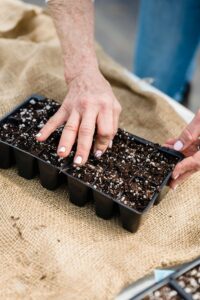Snapdragon (Antirrhinum majus) is a popular flowering plant known for its distinctive, snap-like blooms and vibrant colors. Native to the Mediterranean region, snapdragons have been cultivated for centuries and are cherished for their ornamental value in gardens and floral arrangements.
The name “snapdragon” comes from the flower’s resemblance to a dragon’s mouth that opens and closes when squeezed gently from the sides, mimicking the motion of a snapping jaw. This unique feature has contributed to the flower’s popularity and playful charm.
As cut flowers, snapdragons offer a charming and elegant addition to bouquets, centerpieces, and floral designs. Their unique shape and vibrant hues add texture, height, and visual interest to any arrangement. Snapdragons are available in a wide range of colors, including white, yellow, pink, red, orange, and purple, making them suitable for various color schemes and design styles.

One of the key features that make snapdragons ideal for cutting is their long-lasting blooms. When harvested at the right stage, snapdragon flowers can last up to a week or more in a vase, providing enduring beauty and enjoyment. Additionally, snapdragons produce multiple blooms on each stem, offering a plentiful supply of flowers for arranging.
Growing snapdragons specifically for cutting is a rewarding endeavor that allows gardeners to enjoy an abundance of fresh-cut flowers throughout the growing season. With proper care and maintenance, snapdragons can thrive in gardens, providing an ongoing supply of blooms for cutting and bringing indoors.
Sunlight Requirement of Snapdragon Flowers
Providing them with at least 6 to 8 hours of direct sunlight daily encourages robust growth and abundant flowering. Placing them in a location with ample sunlight exposure will promote strong, healthy stems and vibrant flower development, making them ideal candidates for cut flower arrangements.
Temperature Requirement of Snapdragon Flower
Temperature: Snapdragon plants thrive in temperatures ranging from 55°F to 75°F (13°C to 24°C). They generally perform best in cooler climates, but they can tolerate some heat if provided with adequate moisture and protection from intense afternoon sun.
Soil Requirement of Snapdragon Flower
Snapdragon flowers prefer well-draining soil that is rich in organic matter. Snapdragons prefer slightly acidic to neutral soil with a pH level between 6.0 and 7.0. The soil should be fertile to support healthy growth and abundant flowering. Before planting, amend the soil with a balanced fertilizer or compost to provide essential nutrients.
Sowing of Snapdragon Seeds
Fill seed trays or flats with a well-draining potting mix. Ensure the trays have drainage holes at the bottom to prevent waterlogging.
Sow Snapdragon seeds thinly and evenly across the surface of the potting mix. Press them lightly into the soil surface, but do not bury them too deeply, as Snapdragon seeds require light for germination.
Gently water the soil surface to moisten it without causing water pooling. Use a fine mist or a watering can with a rose attachment to avoid displacing the seeds.
Cover the seed trays with a plastic dome or clear plastic wrap to create a humid environment that promotes germination. Place the trays in a warm location with indirect sunlight.
Check the trays regularly to ensure the soil remains evenly moist but not waterlogged. Mist the soil surface if it begins to dry out. Maintain a consistent temperature of around 70-75°F (21-24°C) for optimal germination.

Once the Snapdragon seeds germinate and seedlings emerge, remove the plastic cover to prevent excessive humidity buildup, which can lead to damping-off disease.
Place the trays in a location with bright, indirect sunlight or under grow lights to promote healthy seedling growth. Rotate the trays regularly to ensure even light exposure.
Once the seedlings develop their first true leaves and are large enough to handle, thin them out to avoid overcrowding. Leave only the strongest, healthiest seedlings spaced about 2-3 inches apart.
About 1-2 weeks before transplanting outdoors, gradually acclimate the seedlings to outdoor conditions by exposing them to increasing amounts of sunlight and outdoor temperatures. Start with a few hours of exposure per day and gradually increase the duration over the course of a week.
When the seedlings are well-established and all risk of frost has passed, transplant them into the garden or larger containers spaced according to the specific variety’s requirements. Ensure the soil in the planting area is well-prepared and amended with compost or organic matter to provide nutrients for healthy growth.
By following these steps, you can successfully sow Snapdragon seeds in trays for transplanting, ensuring a bountiful supply of beautiful flowers for cutting.
Water Requirements
Water snapdragons regularly to keep the soil consistently moist but not waterlogged. Aim to water deeply, saturating the root zone, rather than light, frequent watering which encourages shallow root development. Consider using drip irrigation or soaker hoses to deliver water directly to the soil around snapdragon plants, minimizing water waste and reducing the risk of foliar diseases.
Fertilizer Requirement of Snapdragon Flowers
To ensure healthy growth and abundant flowering, snapdragon cut flowers benefit from regular fertilization. Use a balanced, water-soluble fertilizer with equal parts nitrogen (N), phosphorus (P), and potassium (K), such as a 10-10-10 or 20-20-20 formulation. This provides essential nutrients for overall plant growth and flower production. Apply fertilizer every 2-4 weeks during the growing season, typically from spring to early fall. Avoid over-fertilizing snapdragons, as excessive nitrogen can promote lush foliage growth at the expense of flower production.

Stalking
Using netting to support snapdragon flowers grown as cut flowers can be an effective method to get straight and tall cut flowers.
Choose a lightweight, flexible netting material that provides enough support for the snapdragon stems without being too rigid. Nylon or plastic netting with small grid sizes works well for this purpose.
Install the netting support structure before or shortly after planting snapdragon seedlings. Position sturdy stakes or poles along the rows or beds of snapdragons, spacing them at intervals of about 3 to 4 feet apart.
Unroll the netting and stretch it between the stakes, ensuring it is taut and positioned at an appropriate height to support the snapdragon stems as they grow. Secure the netting to the stakes using garden twine, plastic ties, or clips.
As the snapdragon plants grow, periodically check the netting to ensure it continues to provide adequate support. Adjust the tension of the netting or add additional ties as necessary to prevent sagging and keep the snapdragon stems upright.
Encourage the snapdragon stems to grow through the openings in the netting as they emerge. Gently guide the stems towards the netting and weave them through the grid openings to provide additional support and help keep them upright.
Monitor the snapdragon plants regularly throughout the growing season, especially during periods of rapid growth or inclement weather. Check the netting for any signs of damage or strain, and make adjustments as needed to maintain proper support.
When it’s time to harvest the snapdragon flowers, carefully lift the netting away from the plants to access the blooms. After the flowering season, remove the netting from the support stakes and store it for future use.
By using netting to stake snapdragon flowers, you can provide effective support for their tall stems while allowing for optimal air circulation and sunlight penetration. This method helps prevent the snapdragon plants from bending or breaking under the weight of their flowers, resulting in a more abundant and beautiful harvest of cut flowers.

Harvesting of Snapdragon cut flower
Harvesting snapdragon cut flowers is a straightforward process that, when done correctly, encourages continued blooming and ensures the best quality blooms for arrangements. Here’s a guide on how to harvest snapdragon cut flowers:
Wait until the snapdragon flowers have fully opened and are showing vibrant color before harvesting. The ideal time to harvest is in the morning or late afternoon when the flowers are well-hydrated and temperatures are cooler.
Use clean, sharp garden shears or scissors for harvesting. Dull blades can crush the stems and inhibit water uptake, leading to premature wilting.
Cut snapdragon stems to the desired length for your arrangements. Typically, stems are cut to about 8 to 12 inches long, depending on the intended use and container size.
Position the shears or scissors at a 45-degree angle just above a leaf node or lateral bud. Make a clean, swift cut to avoid crushing the stem. Cutting above a node encourages new growth and branching.
After cutting, place the harvested snapdragon stems into a bucket or vase filled with lukewarm water. This helps prevent air bubbles from forming in the stems, ensuring optimal hydration and prolonging vase life.
Strip any foliage from the lower portion of the stems that will be submerged in water. Foliage left below the waterline can decay and promote bacterial growth, shortening the vase life of the flowers.
Check the water level in the vase or bucket daily and replenish it as needed to keep the snapdragon flowers hydrated.

By following these harvesting guidelines, you can enjoy a bountiful supply of snapdragon cut flowers throughout the growing season. Regular harvesting not only provides you with beautiful blooms for arrangements but also encourages the plant to produce more flowers, extending the flowering period.


